SCOFF
The peculiarly South African story of kitke
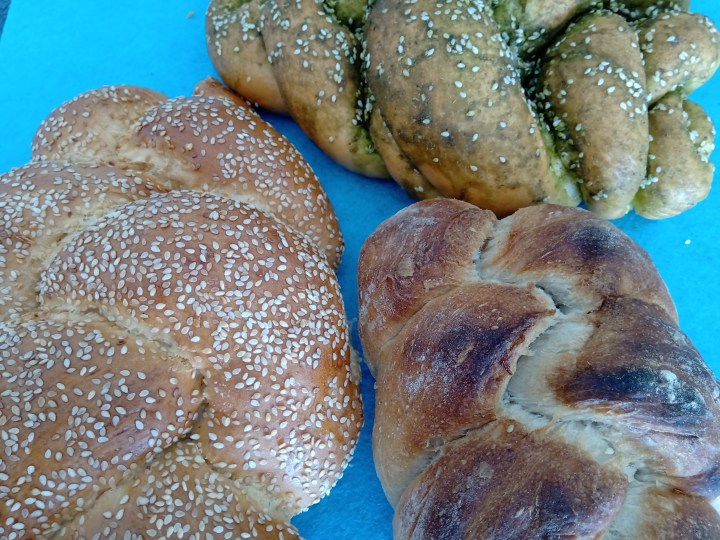
Kitke is a spiritually significant, deeply delicious braided bread garnished with South African stories.
I blame Refiloe Mpakanyane. The Talk Radio 702 presenter and I do a regular Saturday morning food feature on her Weekend Breakfast Show and, in the course of some amiable chitchat, Refiloe mentioned her fondness for the Jewish ceremonial braided bread that South Africans often call kitke and the rest of the world generally refers to as challah. Whereupon I got completely carried away and volunteered to go on a kitke quest. My self-appointed mission was to taste test and report back the following week on Johannesburg’s finest examples of this slightly sweet, egg and oil enriched, golden crusted white bread. I foolishly asked listeners for recommendations. And, of course, I was inundated.
Such is kitke’s spiritual significance that Kosher eateries only make it for Jewish holidays and on Friday as part of their preparation for the Sabbath. So, I had to wait a week to eat. I used the time to investigate why the word kitke is commonly used in South Africa and almost unknown elsewhere.
I began by establishing the origins of the internationally understood term challah. Writing in The New York Times, Pulitzer Prize winner Julia Moskin observes that, “The bond among Jews, God and bread goes back to the first five books of the Bible. As the Israelites are about to end their exile, God commands them to show gratitude by setting aside a portion, (‘challah’ in Hebrew), of all the bread they make after entering the Holy Land. But nowhere in Jewish scripture is it written that challah is the braided, sweet, yellow, deliciously squishy bread of the kind familiar to most American Jews, which comes from the rich tradition of Eastern European baking.”
Maggie Glezer (whose magnificent compendium of Jewish baking, A Blessing of Bread, includes a dozen challah recipes) writes that, “Traditionally, challah is defined as any bread that is made for use in Jewish ritual.” She gives Sephardic (Spanish ancestry) Jewish recipes replete with olive oil, honey and spices. There are also fat and sugar free recipes from North African and Middle Eastern Mizrahi Jews. She argues that “it was only in the Ashkenazi world – that of the Jews who made their way over time to Central and Eastern Europe – that challah evolved into the fluffy, egg-enriched, sugar-laced, six-stranded braid that most of us know”.
So, having established that while all kitke are challah, not all challah are kitke, I moved on to querying the origin of this seemingly South African specific term. My research took me to international experts including food historian Darra Goldstein, the founding editor of Gastronomica: The Journal of Food and Culture and author of Beyond the North Wind: Russia in Recipes and Lore (which topped the list of Best Summer Cookbooks 2020 in The New York Times Book Review) and Jeffrey Yoskowitz, chef-patron New York’s Gefilteria and co-author of The Gefilte Manifesto: New Recipes for Old World Jewish Foods. While both Darra and Jeffrey were very familiar with the recipe and its accompanying rituals, both used the word challah and neither had heard the term kitke before I emailed them.
So, where does kitke come from? Writing in the South African Jewish Report in 2010 Isaac Reznik postulated that the word was derived from “the Griqua term ‘kitkoi’, meaning twisted” and that its origins lie in 19th century cultural crossover on the Kimberley diamond fields. The Northern Cape story makes for charming folk law but it is almost certainly factually incorrect. Volume 3 of the YIVO institute for Jewish Research Language and Culture Atlas devotes nine pages (with maps) to the very many words for Sabbath and festival breads that were once baked across Ashkenazic Europe. Khale, berkhes, barches, bukhte, dacher, koylatch, koilitsh, shtritsl and our very own kitke are all offered up. Kitke is listed as the Litvishe Yiddish dialect term used within what was the territory of the Grand Duchy of Lithuania. Since the vast majority of South African Jews have Lithuanian ancestry it is safe to assume that they brought the recipe and its regionally specific name with them. Further evidence of its epicurean ancestry came when Chef Yoskowitz kindly connected me with the owners of Beigelių Krautuvėlė, a Jewish revival bakery in Vilnius who wrote that: “Yes, we know kitke, it is literally ‘braided’. We use it as a verb.”
While almost all South African Jews have Lithuanian ancestry, not all those who fled first pogroms and then Nazis in Lithuania ended up in Africa. Those who emigrated to countries with a larger, more diverse Diaspora Jewish community assimilated into a generalised Ashkenazi identity within which many Litvak specific linguistic markers were lost. Which is presumably why American authors Yoskowitz and Goldstein had never come across the word kitke.
As Friday drew near, I worried less about nomenclature and more about the eating of all that kitke alone. So, I asked my friend Chef Siya Kobo to accompany me on my carb-laden mission. While Siya’s presence eased my anxiety about quantity, I was still concerned about the quality of our upcoming assessment. I was unsure if it was possible and/or appropriate to try to judge kitke as one would a secular loaf. The Torah commands: “You shall offer up a loaf (challah) from the first of your dough as a gift.” It is symbolic of Shabbat, the day of rest and an edible manifestation of cherished time spent with family. Each bread is kneaded into existence to commemorate the Biblical manna that fell from heaven. The plaited strands of dough form 12 undulations which represent the 12 ceremonial shewbreads, one for each of the 12 tribes of Israel, kept in the Temple in Jerusalem. Before baking a small piece of each loaf is separated out to be burnt as an offering in remembrance of the lost Temple. As Siya and I set about eating ourselves into oblivion it became clear that those who have not seen and felt the intense, focused, close knit community buzz of Friday morning kitke queues in Johannesburg’s Kosher bakeries are missing out on at least half the flavour.
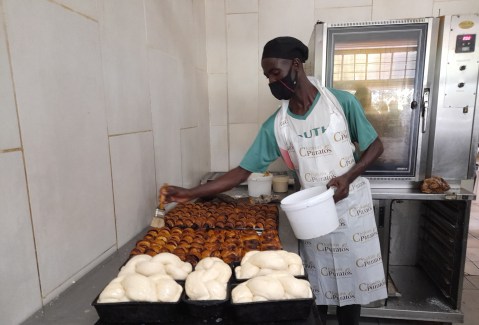
Kitke ready to bake at The Friends Bakery Sandringham. (Photo Anna Trapido)
Speaking of buzz, there were bees hovering over the kitke in all the Kosher eateries we visited. Siya spotted them first. He pointed and murmured “umyalezo wezinyanya” (messages from the ancestors). In Xhosa cosmology bees exist as a conduit for spiritual statements. A bee flying into a home, a sting or even a wild hive taking up residence in a roof are all understood as indications of generations past seeking to communicate and/or correct living members of their lineage. Surrounded as I was by the hustle and bustle of shoppers preparing for the approaching Sabbath, just as their parents, grandparents and great grandparents had done before them, I had no reason to doubt Siya’s interpretation of events.
Words are important. The World War II genocide by Nazi Germany and its collaborators was a systematic attempt to destroy all aspects of Jewish life and culture. Food culture was among the hardest hit because most cooking knowledge is rooted in oral tradition. Recipes are most often transmitted from mother to child as edible connections across time. Using heritage recipes and food terminology demonstrates the survival of ancestral influence.
Mass participation, international link up events such as the Shabbos Project’s Great Big Challah Bake at Johannesburg’s Norwood Mall show that many younger South African Jews use the word “challah” rather than kitke. This suggests an increasingly international identity linked to the use of the Hebrew term rather than a Yiddish and shtetl specific kitke culinary identity. Both words are an indication of resilient links between past and present and both are beautiful and precious but while challah’s survival is secure kitke is in danger of being lost. Maybe that’s why the bees were buzzing.
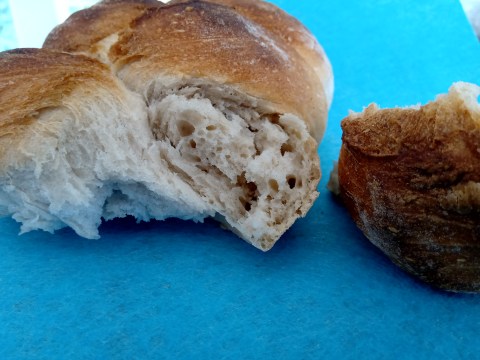
Dee Jay’s Deli sourdough kitke. (Photo: Anna Trapido)
So, we ate and ate and ate. Of those shops supervised by the Beth Din, our four favourites were Tiberius Fish Emporium, The Friends Bakery, Dee Jay’s Kosher Deli and Shoshana’s. They all made multiple variations on the kitke theme but each had a standout speciality. Tiberius (74 George Avenue, Sandringham) sells a superb sesame-sprinkled kitke with a beautifully golden, shiny, egg washed exterior and a pleasantly sweet and pillow-soft interior.
The za’atar garnished kitke from The Friends Bakery in Glendale (17 Anne St, Sandringham) has a lovely depth of flavour with a slightly sweet but not overly rich centre and an exquisitely aromatic herbal crunchy crust. The sourdough kitke from Dee Jay’s (83 3rd Ave Percelia Estate) had a hint of tanginess to balance sweetness. Sweet toothed Siya was particularly partial to the fabulously fluffy chocolate kitke from Shoshanna’s on the corner of Queens Street and Cross Rd, Glenhazel.
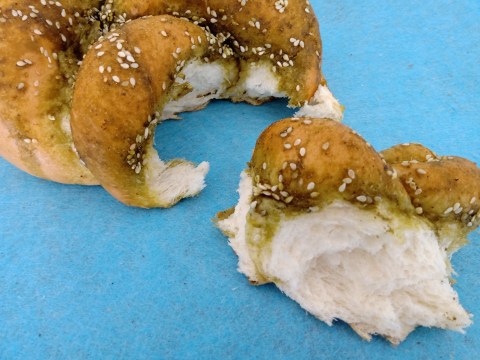
The Friends Bakery za’atar kitke. (Photo: Anna Trapido)
There was only one really dud dough. Brioche (and many other enriched European breads) contain butter and/or milk whereas kitke is traditionally Pareve (containing neither dairy nor meat). One bakery (that shall remain nameless) makes a curious concoction listed as “brioche kitke”. It is made with a non-dairy butter substitute and we both found it to be too rich, too eggy, too sweet and too dense with an oddly slimy, sticky mouthfeel.
A word to the wise: the early bird catches the kitke. Most of the Kosher venues sell out long before they close at 3pm on Friday. Such is the demand that telephonic booking of bread the day before is advisable. Even with a reserved loaf, queues for collection are long. If you miss the 3pm deadline, the Spar supermarkets in Norwood and Edenvale both make kitke on Friday and keep late night hours.
For those who simply must have freshly baked kitke every day, Romi Brozin Rabinowitz’s recipe (@eversolovelysa) is super easy and super delicious. Be aware that the quantities in Romi’s recipe are large. Robyn Smookler, founder of the Challah Bake project, explains that “there is a minimum amount of dough that you have to make to be able to say blessing over the dough. It’s around 1.2kg of flour”. I halved Romi’s recipe and still created an enormous braided bread.
If you are too busy to bake, Fordsburg is your best bet. Many bakeries in this predominantly Muslim neighbourhood make and sell kitke from recipes that would not be out of place in a Kosher kitchen. If you are seeking out kitke on a Tuesday, religious ritual is probably not your main motivation but just in case, remember that ritually-acceptable kitke is made of dough from which a small portion has been set aside as an offering and this aspect of the method is not happening in the Fordsburg bakeries.
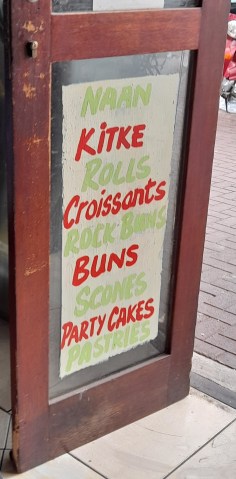
Naan and kitke advertised together at Divine Bakery Fordsburg. (Photo Anna Trapido)
The kitke at Divine Bakery on Mint Road and Saleh’s Bakery on Central Road, Fordsburg were both repeatedly recommended by 702 listeners. So, we went there too. Divine’s kitke was gloriously golden with a fluffy, tender crumb while Saleh’s literally melts in the mouth. In Fordsburg I saw no signs of the beneficiated kitkes (za’atar, brioche-style, chocolate, streusel crusted) that were made in the Jewish bakeries but what they lacked in add-ons to the basic recipe, they made up for in daily availability. The only time kitke is not available at Divine and Saleh’s is Friday between 12 and 2 when both shops close and staff go to the mosque.
The original kitke makers came from a cluster of closely related Eastern European villages within a small radius of each other but the communities that they encountered in Africa were much more multicultural. While researching her PhD on 19th century South African Jewish women Veronica Belling came across the oldest known Yiddish language Jewish cookbook at the Cape. Kokh-bukh far Yudishe Froyen by Ozer Bloshteyn (published in Vilna in 1896) contains a recipe for (and uses the term) kitke. The inside cover bears the stamp of Smith Jewish Booksellers, Harrington Street in Cape Town’s District Six. Perhaps it was in the diversity of areas such as District Six and Fordsburg that kitke became part of a broader South African story. Perhaps employment maid and madam interactions were involved. What I do know is that the only word used in Fordsburg is kitke. When I asked about challah no one knew what I meant, which indicates that the recipe was learnt not from international books or travel but rather in a South African setting.
Moses and manna from heaven feature in the Qur’an as well as the Torah so I asked Mohammed Saleh from Saleh’s Bakery whether or not kitke held any religious significance for him but he said “no, we just like it. We’ve always made it. My father makes it, my grandfather made it. It goes great with curry”.
Almost all of the bakery-bought breads mentioned above were very nice but none quite as good as Romi Brozin Rabinowitz’s recipe. Kneading kitke dough allows for an active and intensely moving interaction between past and present and no commercial transaction can replace the rapture that comes with mastering the art of six stranded dough plaits. As the people at the Beigelių krautuvėlė, bakery in Vilnius said, kitke is a verb.
Romi’s recipe
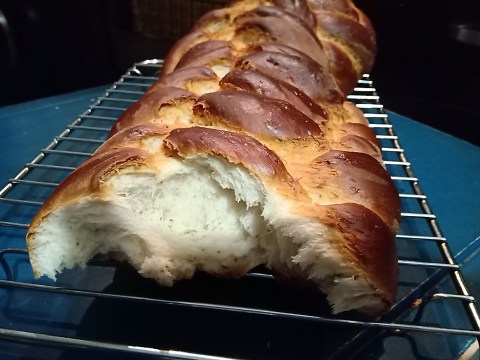
Anna’s handmade kitke made using Romi’s recipe. (Photo: Anna Trapido)
(This will make 3 or 4 loaves)
14 cups flour
4 x 10 g packets instant dry yeast
2 eggs, beaten lightly
1 cup oil
2 Tbsp salt
1 ½ cups sugar
4 cups lukewarm water
Method
Place half the flour, the salt, the sugar and the yeast into a large bowl. Make a well in the centre and add the eggs, water and oil.
Gradually add the flour to make a soft (not sticky) dough. You may not need to use all 14 cups of flour – although in the South African summer heat I did.
Knead the dough for around 10 minutes. Oil the dough and place it in a bowl that has also been oiled. Cover the bowl with a damp cloth and allow it to rise in a warm place for around two to three hours.
Punch the dough down and knead it briefly. If you are making a full 14 cup recipe, divide the dough into four portions. If you have halved the recipe you can make one very big loaf or two medium loaves.
Further divide each section into three for a normal braid or six if you are feeling super fancy. Roll into long strands (about 30 cm each). You will then plait the strands to make a kitke.
If you are making a 6-stranded plait, line the strands up and pinch the top end together. Now start plaiting. Don’t panic. It sounds hard but it isn’t, And you will be so proud when you do it again. Working from right to left. Over 1, Under 2, Over 2. Then start again. Working from right to left. Over 1, Under 2, Over 2. Keep going until it is all plaited up. Pinch the end together.
Gently lift onto a sprayed baking tray. Allow to rise again for 20 to 30 minutes. Brush the top with beaten egg and sprinkle the top with poppy or sesame seeds.
Bake at 180℃ for around 20 to 30 minutes until browned on top and cooked through. DM/TGIFood
The author supports The Saartjie Baartman Centre for Women and Children in Manenberg. Their 24-hour crisis response service provides holistic social work support which includes housing and feeding up to 120 survivors of domestic violence daily. See Saartjie Baartman Centre.



 Become an Insider
Become an Insider
Comments - Please login in order to comment.